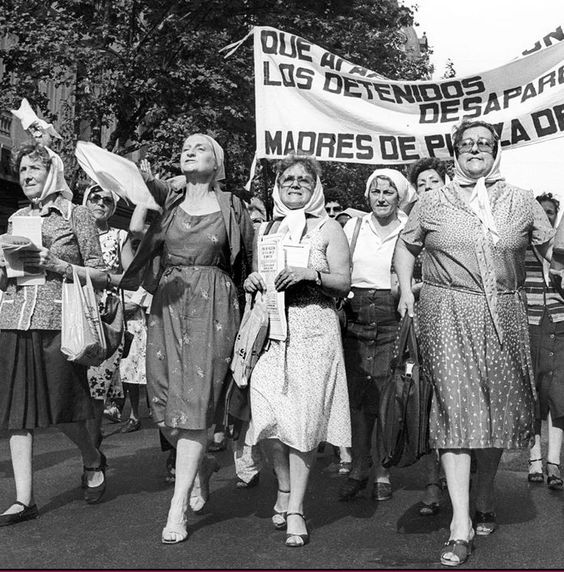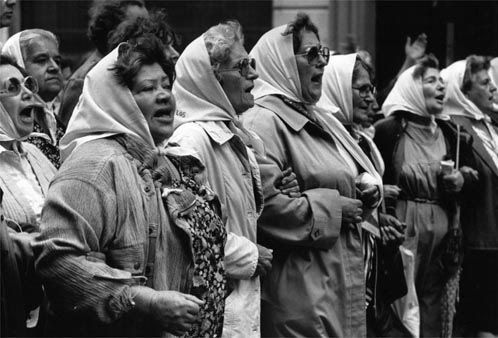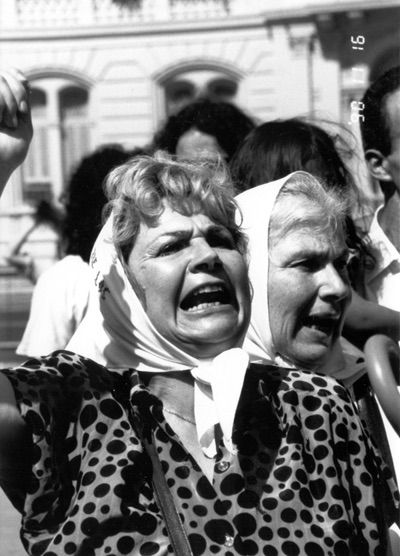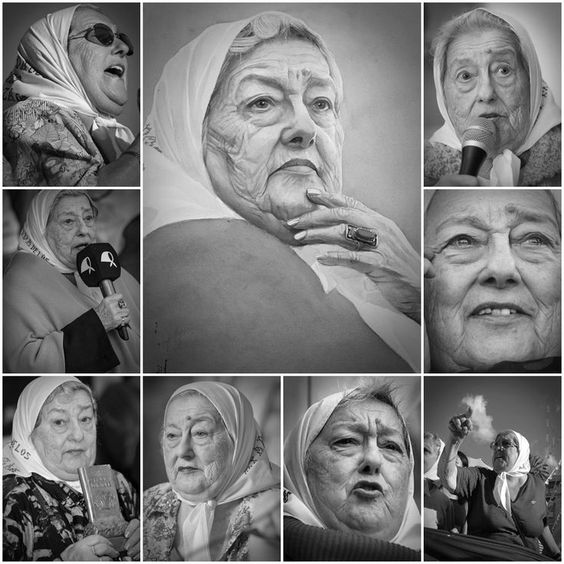During the 1970s, a turbulent period in the history of the Argentine Dictatorship, a group of mothers—dressed in mourning and carrying white scarves—began gathering at the Plaza de Mayo in Buenos Aires. This movement, initiated by ordinary women, became a symbol of resistance, solidarity, and above all, an unrelenting search for justice. In this article, we will explore how and why the Mothers of Plaza de Mayo emerged, their impact on the Argentine Dictatorship, and the lasting legacy of the Mothers of Plaza de Mayo in the fight for human rights.

The Argentine Dictatorship and the “Disappearance” of Thousands
To understand the emergence of the Mothers of Plaza de Mayo, it’s important to revisit the history of the Argentine Dictatorship, especially the period from 1976 to 1983, when the country was under military rule. This government imposed extreme repression, known as the “Dirty War” or “State Terrorism,” in which activists, students, unionists, teachers, journalists, and anyone considered a threat to the regime were targeted for persecution, torture, and “disappearance.”
It’s estimated that around 30,000 people disappeared during this period. Many were taken to secret detention centers, where they were tortured and often executed. Their bodies were never found, and the lack of information led to the creation of the term “desaparecidos” (disappeared) to describe the victims. With little or no explanation from authorities, these people simply vanished. In this context of violence and silence, an unlikely group of voices rose up.
The Emergence of the Mothers of Plaza de Mayo
The First Gathering at Plaza de Mayo
On April 30, 1977, a small group of women gathered in Plaza de Mayo, the main square of Buenos Aires, located in front of the Casa Rosada, the seat of government. These women were mothers and grandmothers who, desperate for news about the whereabouts of their children, decided to meet in a symbolic act—seeking support and sharing their grief.
Among them was Azucena Villaflor, who became one of the movement’s main leaders. Like many of the other mothers, Azucena had a son who disappeared after being detained by the government’s security forces. She and the other mothers decided to continue meeting weekly in Plaza de Mayo, marching in silence in circles, holding photos of their missing children.
The Choice of the White Scarf
One of the most recognizable symbols of the Mothers of Plaza de Mayo is the white scarf they wear on their heads. This scarf was adopted as a symbol of their struggle and represents the purity and memory of their children. Originally, the scarves were white baby diapers— a symbolic choice that referenced motherhood and infancy, emphasizing that those young men and women who disappeared were still seen as children in the eyes of their mothers.
This visual symbol, though simple, was a powerful decision that helped give the movement a unique identity. The white scarf became a symbol of resistance that echoed around the world and became part of the collective memory of the Argentine Dictatorship: the Mothers of Plaza de Mayo.

The Silent March and Its International Impact
The Division and Growth of the Movement

The Role of the Grandmothers of Plaza de Mayo
As the movement grew stronger, a new struggle joined the mothers’ quest. It was discovered that many pregnant women who had been kidnapped gave birth in captivity, and their babies were handed over to other families. This new group, known as the “Grandmothers of Plaza de Mayo,” began organizing to find these children, who had been separated from their biological families and, in many cases, grew up without knowing their true identity.
This group created a system to trace these children, combining records, interviews, and more recently, DNA testing. To this day, they continue to identify and reunite these children—now adults—with their biological families.
The Internationalization of the Movement
Over the years, the Mothers of Plaza de Mayo movement received support from public figures and human rights organizations. Their struggle inspired the emergence of similar movements in other Latin American countries where dictatorships also occurred. Additionally, the work of the Mothers of Plaza de Mayo helped establish the concept of “Memory, Truth, and Justice,” which became the foundation of human rights struggles related to the Argentine Dictatorship—The Mothers of Plaza de Mayo and beyond.
The Lasting Legacy of the Mothers of Plaza de Mayo
Recognition and Collective Memory
With the end of the Argentine Dictatorship in 1983, the struggle of the Mothers of Plaza de Mayo continued. Even with the return of democracy, the movement pressured the government to investigate and hold accountable those involved in the disappearances and human rights violations. Thanks to the persistence of these women, laws were passed and institutions were founded to ensure that the memory of these events would be preserved.
Today, Plaza de Mayo is a symbol of resistance, and the struggle of the mothers is remembered in schools, monuments, and cultural events. Every year, Argentinians commemorate the National Day of Memory for Truth and Justice on March 24, honoring the victims of the dictatorship and the women who fought for them.
The Pursuit of Justice
Despite their achievements, the Mothers of Plaza de Mayo’s pursuit of justice is not over. Many of those responsible for human rights violations during the dictatorship have been tried and convicted, but some investigations are still ongoing. Families of the victims continue to seek answers about what really happened to their loved ones.
Moreover, the Mothers of Plaza de Mayo have become a kind of “conscience” of Argentine society, constantly reminding the country of its responsibility to protect democracy and human rights.
“Aparición con vida y castigo a los culpables.”

Hebe de Bonafini (1928-2022) was one of the leading figures of the Mothers of Plaza de Mayo movement, emerging as a tireless defender of human rights and justice in Argentina.
After the disappearance of her two sons during the military dictatorship (1976–1983), she joined other mothers and, in 1979, took on a leadership role in the movement, dedicating her life to demanding answers and accountability for the atrocities committed by the regime.
Her struggle and strong public statements made her a controversial and influential figure, known for her courage in confronting the dictatorship and denouncing social injustice. Hebe de Bonafini inspired generations to fight for truth and justice, leaving a profound legacy of resistance and perseverance in the defense of human rights.
An Example of Courage and Persistence
The Mothers of Plaza de Mayo are an example of how a simple and personal struggle can grow and transform into a powerful and lasting movement. These women, who faced the disappearance of their children and the brutality of a repressive regime, remained steadfast in their pursuit of justice—even when it seemed impossible.
They remind us that no matter how difficult the fight may be, determination and commitment to truth can overcome even the most violent regimes. Today, the Mothers of Plaza de Mayo continue to inspire those who believe in justice and human rights, and their story serves as a warning to ensure that such atrocities never happen again.
Sources
Feitlowitz, M. (2011). A Lexicon of Terror: Argentina and the Legacies of Torture. Oxford University Press.
- Explores repression and resistance during the Argentine dictatorship, including the history and impact of the Mothers of Plaza de Mayo.
Guzman Bouvard, M. (1994). Revolutionizing Motherhood: The Mothers of the Plaza de Mayo. Rowman & Littlefield Publishers.
- Discusses the development of the movement and the role of the Mothers as human rights activists in Argentina.
Robben, A. C. G. M. (2005). Political Violence and Trauma in Argentina. University of Pennsylvania Press.
- An in-depth study of the Argentine dictatorship, state violence, and civil society’s response, including the Mothers of Plaza de Mayo.
Taylor, D. (1997). Disappearing Acts: Spectacles of Gender and Nationalism in Argentina’s “Dirty War”. Duke University Press.
- Examines how the Mothers of Plaza de Mayo became a powerful symbolic image of resistance to the dictatorship.
Arditti, R. (1999). Searching for Life: The Grandmothers of the Plaza de Mayo and the Disappeared Children of Argentina. University of California Press.
- Focuses on the Grandmothers of Plaza de Mayo and their efforts to recover the children kidnapped during the dictatorship.
Wright, T. C. (2007). State Terrorism in Latin America: Chile, Argentina, and International Human Rights. Rowman & Littlefield Publishers.
- Analysis of Southern Cone dictatorships and international response, highlighting the Mothers of Plaza de Mayo’s struggle for justice.